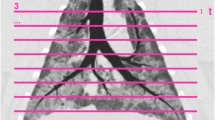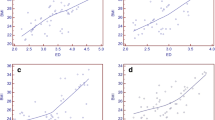Abstract
The purpose of the study was to evaluate both CT image quality in a phantom study and feasibility in an initial case series using automated chest compression (A-CC) devices for cardiopulmonary resuscitation (CPR). Multidetector CT (MDCT) of a chest/heart phantom (Thorax-CCI, QRM, Germany) was performed with identical protocols of the phantom alone (S), the phantom together with two different A-CC devices (A: AutoPulse, Zoll, Germany; L: LUCAS, Jolife, Sweden), and the phantom with a LUCAS baseplate, but without the compression unit (L-bp). Nine radiologists evaluated image noise quantitatively (n = 244 regions, Student’s t-test) and also rated image quality subjectively (1–excellent to 6–inadequate, Mann-Whitney U-test). Additionally, three patients during prolonged CPR underwent CT with A-CC devices. Mean image noise of S was increased by 1.21 using L-bp, by 3.62 using A, and by 5.94 using L (p < 0.01 each). Image quality was identical using S and L-bp (1.64 each), slightly worse with A (1.83), and significantly worse with L (2.97, p < 0.001). In all patient cases the main lesions were identified, which led to clinical key decisions. Image quality was excellent with L-bp and good with A. Under CPR conditions initial cases indicate that MDCT diagnostics supports either focused treatment or the decision to terminate efforts.







Similar content being viewed by others
References
Zheng ZJ, Croft JB, Giles WH et al (2001) Sudden cardiac death in the United States, 1989 to 1998. Circulation 104:2158–2163
Nolan J (2005) European Resuscitation Council guidelines for resuscitation 2005. Section 1. Introduction. Resuscitation 67(Suppl 1):S3–S6
Pell JP, Sirel JM, Marsden A et al (2003) Presentation, management, and outcome of out of hospital cardiopulmonary arrest: comparison by underlying aetiology. Heart 89:839–842
Capucci A, Aschieri D, Piepoli MF et al (2002) Tripling survival from sudden cardiac arrest via early defibrillation without traditional education in cardiopulmonary resuscitation. Circulation 106:1065–1070
Chamberlain D (2005) The International Liaison Committee on Resuscitation (ILCOR)–past and present: compiled by the Founding Members of the International Liaison Committee on Resuscitation. Resuscitation 67:157–161
ECC Committee SaTFotAHA (2005) 2005 American Heart Association Guidelines for Cardiopulmonary Resuscitation and Emergency Cardiovascular Care. Part 6: CPR Techniques and Devices. Circulation 112:IV 47–50
Handley AJ, Koster R, Monsieurs K et al (2005) European Resuscitation Council guidelines for resuscitation 2005. Section 2. Adult basic life support and use of automated external defibrillators. Resuscitation 67(Suppl 1):S7–S23
Abella BS, Alvarado JP, Myklebust H et al (2005) Quality of cardiopulmonary resuscitation during in-hospital cardiac arrest. JAMA 293:305–310
Abella BS, Sandbo N, Vassilatos P et al (2005) Chest compression rates during cardiopulmonary resuscitation are suboptimal: a prospective study during in-hospital cardiac arrest. Circulation 111:428–434
Wik L, Kramer-Johansen J, Myklebust H et al (2005) Quality of cardiopulmonary resuscitation during out-of-hospital cardiac arrest. JAMA 293:299–304
Nolan JP, Deakin CD, Soar J et al (2005) European Resuscitation Council guidelines for resuscitation 2005. Section 4. Adult advanced life support. Resuscitation 67(Suppl 1):S39–S86
ECC Committee SaTFotAHA (2005) 2005 American Heart Association Guidelines for Cardiopulmonary Resuscitation and Emergency Cardiovascular Care. Part 4: Adult Basic Life Support. Circulation 112:IV19–34
Deakin CD, Paul V, Fall E et al (2007) Ambient oxygen concentrations resulting from use of the Lund University Cardiopulmonary Assist System (LUCAS) device during simulated cardiopulmonary resuscitation. Resuscitation
Casner M, Andersen D, Isaacs SM (2005) The impact of a new CPR assist device on rate of return of spontaneous circulation in out-of-hospital cardiac arrest. Prehosp Emerg Care 9:61–67
Steen S, Sjoberg T, Olsson P et al (2005) Treatment of out-of-hospital cardiac arrest with LUCAS, a new device for automatic mechanical compression and active decompression resuscitation. Resuscitation 67:25–30
Timerman S, Cardoso LF, Ramires JA et al (2004) Improved hemodynamic performance with a novel chest compression device during treatment of in-hospital cardiac arrest. Resuscitation 61:273–280
Vatsgar TT, Ingebrigtsen O, Fjose LO et al (2006) Cardiac arrest and resuscitation with an automatic mechanical chest compression device (LUCAS) due to anaphylaxis of a woman receiving caesarean section because of pre-eclampsia. Resuscitation 68:155–159
Kanz KG, Korner M, Linsenmaier U et al (2004) Priority-oriented shock trauma room management with the integration of multiple-view spiral computed tomography. Unfallchirurg 107:937–944
Herlitz J, Svensson L, Engdahl J et al (2008) Characteristics and outcome in out-of-hospital cardiac arrest when patients are found in a non-shockable rhythm. Resuscitation 76:31–36
Steen S, Liao Q, Pierre L et al (2002) Evaluation of LUCAS, a new device for automatic mechanical compression and active decompression resuscitation. Resuscitation 55:285–299
Rubertsson S, Karlsten R (2005) Increased cortical cerebral blood flow with LUCAS; a new device for mechanical chest compressions compared to standard external compressions during experimental cardiopulmonary resuscitation. Resuscitation 65:357–363
Halperin HR, Paradis N, Ornato JP et al (2004) Cardiopulmonary resuscitation with a novel chest compression device in a porcine model of cardiac arrest: improved hemodynamics and mechanisms. J Am Coll Cardiol 44:2214–2220
Ikeno F, Kaneda H, Hongo Y et al (2006) Augmentation of tissue perfusion by a novel compression device increases neurologically intact survival in a porcine model of prolonged cardiac arrest. Resuscitation 68:109–118
Rubertsson S, Huzevka T (2006) Increased restoration of spontaneous circulation after cardiac arrest with the LUCAS device compared to manual chest compressions–A pilot study. Resuscitation 69:46
Ong ME, Ornato JP, Edwards DP et al (2006) Use of an automated, load-distributing band chest compression device for out-of-hospital cardiac arrest resuscitation. JAMA 295:2629–2637
de Knock J, Martens P, Müller N (2006) The use of LUCAS for in- and out-of-hospital cardiac arrests. Resuscitation 69:305
Halliwell D (2004) Evaluation of LUCAS by Dorset Ambulance Service. Br J Resusc 3:10–11
Sampson MA, Colquhoun KB, Hennessy NL (2006) Computed tomography whole body imaging in multi-trauma: 7 years experience. Clin Radiol 61:365–369
Ladner E, Mair P, Mayr A et al (1996) CT scanning as a helpful tool for decision-making during CPR. Resuscitation 31:171–173
Leidel BA, Kunzelmann M, Bitterling H, et al (2008) Computer tomography showing left coronary artery occlusion in a patient having manual chest compressions. Resuscitation [Epub ahead of print] doi:10.1016/j.resuscitation.2008.11.003
Author information
Authors and Affiliations
Corresponding author
Rights and permissions
About this article
Cite this article
Wirth, S., Körner, M., Treitl, M. et al. Computed tomography during cardiopulmonary resuscitation using automated chest compression devices—an initial study. Eur Radiol 19, 1857–1866 (2009). https://doi.org/10.1007/s00330-009-1359-9
Received:
Accepted:
Published:
Issue Date:
DOI: https://doi.org/10.1007/s00330-009-1359-9




